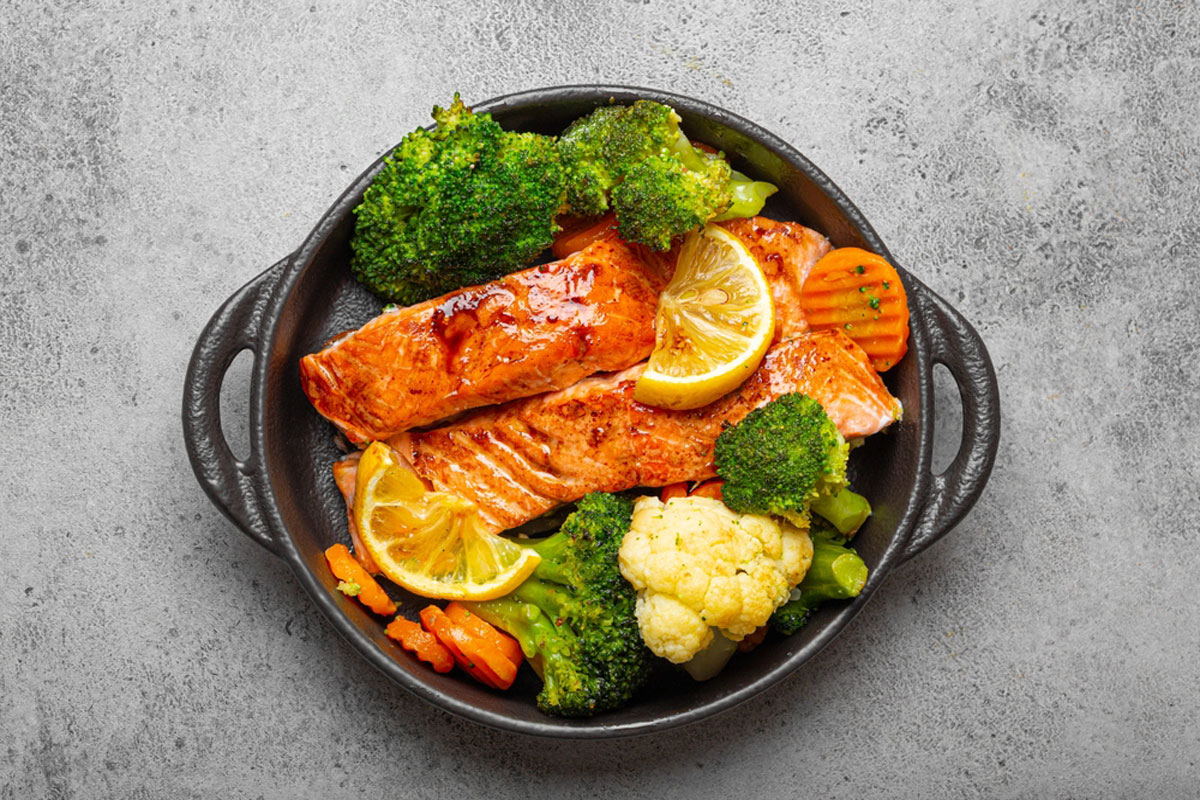Embracing Local and Seasonal Produce
Ireland is known for its lush landscapes, and those green pastures provide an abundance of fresh, healthy ingredients that can be the cornerstone of a nutritious diet. By focusing on local and seasonal produce, you can not only support Irish farmers but also enhance the nutritional value of your meals.
Why Seasonal Eating Matters
Eating with the seasons means consuming fruits and vegetables when they are at their peak ripeness, offering the highest concentration of vitamins, minerals, and flavor. Seasonal produce is also more likely to be fresher and richer in antioxidants, as it doesn’t require long-distance transport. By following the natural harvest cycle, you can enjoy a wide variety of nutrient-dense foods throughout the year.
Examples of Seasonal Irish Produce
- Spring: As the country shakes off the winter chill, springtime brings an array of vibrant, fresh greens. Spinach, kale, and watercress are plentiful, along with tender carrots and leeks. These nutrient-rich vegetables are full of fiber, iron, and vitamin C, supporting overall health and immune function.
- Summer: During the summer months, the Irish countryside is brimming with berries such as blackberries, strawberries, and raspberries. Packed with antioxidants, these fruits are great for heart health and reducing inflammation. You’ll also find zucchini, tomatoes, and fresh herbs, perfect for lighter, refreshing meals.
- Autumn: This season welcomes root vegetables like turnips, parsnips, and potatoes, all high in complex carbohydrates and important for maintaining energy levels. Apples also come into season, making them ideal for nutrient-packed snacks or desserts.
- Winter: Hardy vegetables like cabbage, cauliflower, and Brussels sprouts dominate the winter landscape. These are great for supporting digestion and providing a wealth of vitamins, particularly vitamin K and folate. Pairing them with seasonal fish like mackerel or salmon can further boost your intake of omega-3 fatty acids.
Benefits of Eating Local and Organic
Supporting Irish agriculture by choosing local and organic ingredients means you can avoid the pesticides and chemicals that often come with imported produce. Organic Irish meats and dairy, such as grass-fed beef, lamb, and free-range eggs, are higher in omega-3 fatty acids and offer a healthier balance of fats. These foods, when eaten in moderation, can be excellent sources of protein and essential nutrients.
Simple Recipe: Irish Vegetable Soup
One of the best ways to incorporate seasonal Irish produce into your diet is through a simple, hearty vegetable soup. This versatile dish can be made with whatever vegetables are in season, making it nutrient-dense and easy to prepare.
Ingredients:
- 1 onion, chopped
- 2 carrots, chopped
- 2 parsnips, chopped
- 1 leek, sliced
- 1 potato, diced
- 1 liter vegetable stock
- Fresh parsley, for garnish
Instructions:
- Sauté the onion in a pot until soft.
- Add the carrots, parsnips, leek, and potato, and cook for 5 minutes.
- Pour in the vegetable stock and bring to a boil. Reduce heat and simmer for 25-30 minutes, until the vegetables are tender.
- Blend if desired for a smooth consistency or leave chunky.
- Garnish with fresh parsley and serve warm.
In this simple dish, you get a balanced meal rich in fiber, vitamins, and minerals—all sourced from local, seasonal Irish ingredients.
The Power of High-Quality Irish Proteins
Now let us turn our attention to the importance of incorporating high-quality Irish proteins into your diet. Proteins are essential for muscle repair, immune function, and maintaining energy levels, making them a vital part of healthy eating. Ireland’s lush, green pastures and pristine waters offer a wealth of protein options, including grass-fed beef, free-range poultry, and sustainably sourced fish.
Grass-Fed Beef: Rich in Nutrients
Ireland is world-renowned for its grass-fed beef, and for good reason. Cattle raised on natural pasture produce beef that is leaner and more nutrient-dense than grain-fed alternatives. Grass-fed beef is higher in omega-3 fatty acids, which are known to reduce inflammation and support heart health. It also contains higher levels of conjugated linoleic acid (CLA), a compound believed to aid in fat loss and improve body composition.
Additionally, grass-fed beef is a great source of high-quality protein, iron, zinc, and vitamin B12, all of which are essential for energy production and immune support. Whether enjoyed as a hearty steak or minced in a bolognese, this local protein source provides numerous health benefits.
Free-Range Poultry: A Lean Protein Option
Irish free-range chicken is another excellent source of lean protein. Raised without the use of antibiotics and given room to roam, free-range poultry is not only more ethical but also healthier. It contains lower levels of fat compared to intensively farmed chicken and offers higher levels of essential amino acids that help repair tissue and support healthy metabolism.
Poultry is also rich in B vitamins, particularly niacin (vitamin B3), which helps regulate cholesterol levels and supports brain function. By incorporating free-range chicken into your meals, you can enjoy a nutritious, lean protein that pairs well with a variety of vegetables, grains, and legumes.
Sustainably Sourced Fish: Omega-3 Boost
Ireland’s coastal waters are home to an abundance of fish, including mackerel, salmon, and trout. These cold-water fish are some of the best natural sources of omega-3 fatty acids, which are critical for heart health, cognitive function, and reducing inflammation. In addition to omega-3s, fish is packed with protein, iodine, selenium, and vitamin D, all essential nutrients for maintaining overall health.
Sustainably sourced fish from Irish waters ensures that you’re supporting the environment while benefiting from a nutrient-rich food. Whether grilled, baked, or smoked, fish offers a lighter alternative to red meat without compromising on flavor or nutrition.
Eggs: A Versatile Superfood
Irish free-range eggs are often referred to as a superfood due to their high nutritional value. Eggs are a complete protein, meaning they contain all nine essential amino acids required for muscle repair and growth. In addition to protein, eggs are rich in vitamin D, choline (which supports brain health), and antioxidants such as lutein and zeaxanthin, which protect eye health.
Versatile and easy to prepare, eggs can be incorporated into your diet in numerous ways, from poached eggs for breakfast to adding them to salads or stir-fries for an extra protein boost.
Simple Recipe: Irish Salmon with Mustard and Honey Glaze
Salmon is one of Ireland’s finest seafood offerings, packed with omega-3s and high-quality protein. This easy-to-make recipe combines the richness of Irish salmon with the natural sweetness of honey and the tang of mustard, for a healthy and flavorful dish.
Ingredients:
- 4 salmon fillets
- 2 tbsp wholegrain mustard
- 1 tbsp honey
- 1 tbsp olive oil
- 1 clove garlic, minced
- Salt and pepper, to taste
- Fresh dill, for garnish
Instructions:
- Preheat the oven to 200°C (400°F).
- In a small bowl, mix the mustard, honey, olive oil, garlic, salt, and pepper.
- Place the salmon fillets on a baking sheet and brush the mustard-honey mixture over the top of each fillet.
- Bake for 12-15 minutes, or until the salmon is cooked through and flakes easily with a fork.
- Garnish with fresh dill and serve with seasonal vegetables or a salad.
This simple yet delicious dish highlights the nutritional power of Irish salmon, providing omega-3s and a range of essential vitamins.
The Benefits of Whole Grains and Legumes
These ingredients are rich in fiber, vitamins, and minerals, making them ideal for maintaining energy levels, supporting digestion, and improving heart health. Ireland’s climate and soil conditions make it a prime location for growing some of the most nutritious grains and legumes available.
Why Whole Grains Matter
Whole grains are grains that contain all three parts of the kernel: the bran, germ, and endosperm. Unlike refined grains, which are stripped of these components, whole grains retain more nutrients, including fiber, B vitamins, and important minerals such as iron and magnesium. Eating whole grains regularly can help regulate blood sugar levels, lower cholesterol, and reduce the risk of heart disease and stroke.
Irish Whole Grains to Include in Your Diet
- Oats: Ireland’s cool and rainy climate is perfect for growing oats, which are a staple in Irish kitchens. Oats are packed with soluble fiber, particularly beta-glucan, which is known to reduce cholesterol levels and support heart health. A warm bowl of porridge made from Irish oats is a nutritious and satisfying way to start the day. Oats can also be used in baking for breads, cookies, and granola bars.
- Barley: Another grain with a long history in Irish agriculture, barley is a versatile whole grain high in fiber and antioxidants. It helps promote healthy digestion and can lower blood sugar levels. Barley is often used in soups and stews, adding a chewy texture and nutritional boost. Pearl barley, which has the bran removed, is less fibrous but still offers significant health benefits.
- Rye: Though less common, rye is a nutrient-dense whole grain that grows well in Ireland’s temperate climate. It contains more fiber than wheat and has a lower glycemic index, making it a good choice for managing blood sugar. Rye flour can be used to make traditional Irish soda bread or added to other baked goods for a heartier texture.
The Power of Irish Legumes
Legumes, also known as pulses, are another important part of a healthy diet. Rich in plant-based protein, fiber, and essential nutrients like folate and potassium, legumes are excellent for supporting heart health, reducing cholesterol, and improving digestion. Ireland has a tradition of growing legumes such as peas and broad beans, which thrive in its mild climate.
- Peas: Irish-grown peas, particularly garden peas, are a great source of plant-based protein and dietary fiber. They are also rich in vitamin C and iron. Whether added to soups, salads, or as a side dish, peas can provide a filling, nutritious addition to meals.
- Lentils: Though lentils are not traditionally grown in Ireland on a large scale, they are becoming increasingly popular in Irish cuisine. Lentils are high in protein and fiber, making them a staple in vegetarian diets. They also provide folate, iron, and magnesium. Red, green, and brown lentils can be used in soups, stews, or curries.
- Broad Beans: Known as fava beans in some regions, broad beans are grown in Ireland during the cooler months and are high in protein, fiber, and vitamins like B6 and folate. They are a nutritious addition to salads, soups, or served simply with olive oil and herbs.
Simple Recipe: Barley and Lentil Stew
This wholesome barley and lentil stew is a perfect example of how to incorporate Irish whole grains and legumes into your diet. It’s packed with fiber, protein, and a variety of vitamins, making it a nutritious and satisfying meal.
Ingredients:
- 1 onion, chopped
- 2 carrots, chopped
- 2 celery stalks, chopped
- 2 cloves garlic, minced
- 100g (3.5 oz) pearl barley
- 100g (3.5 oz) green or brown lentils
- 1 liter (34 fl oz) vegetable stock
- 1 can (400g) chopped tomatoes
- 1 tsp thyme
- 1 bay leaf
- Salt and pepper, to taste
- Fresh parsley, for garnish
Instructions:
- In a large pot, sauté the onion, carrots, celery, and garlic until soft.
- Add the pearl barley and lentils, stirring to combine with the vegetables.
- Pour in the vegetable stock and chopped tomatoes, and add the thyme and bay leaf.
- Bring the stew to a boil, then reduce the heat and simmer for 45-50 minutes, or until the barley and lentils are tender.
- Season with salt and pepper, and garnish with fresh parsley before serving.
This hearty stew is a fantastic way to enjoy the benefits of whole grains and legumes, offering plenty of fiber and plant-based protein to keep you full and energized.
The Nutritional Benefits of Irish Dairy
Irish dairy products are renowned worldwide for their high quality, largely due to the country’s rich, fertile pastures where cows graze freely. Grass-fed dairy is a significant part of many Irish meals and offers a wealth of nutritional benefits, from healthy fats to essential vitamins and minerals.
The Advantages of Grass-Fed Dairy
Ireland’s unique climate, with its abundant rainfall and temperate conditions, allows cattle to graze on grass for most of the year. This grass-fed diet directly impacts the nutritional profile of Irish dairy, making it richer in nutrients compared to conventionally produced dairy.
- Higher Omega-3 Fatty Acids: Grass-fed dairy products, including milk, butter, and cheese, have higher levels of omega-3 fatty acids, which are essential for brain function and reducing inflammation.
- Conjugated Linoleic Acid (CLA): This naturally occurring fatty acid, found in grass-fed dairy, has been linked to various health benefits, such as improved immune function, reduced body fat, and lower cancer risk.
- Vitamins and Minerals: Irish dairy is rich in fat-soluble vitamins like vitamin A, which supports eye health and immune function, and vitamin D, which is essential for bone health. Irish milk, cheese, and butter are also good sources of calcium, potassium, and phosphorus—key minerals for maintaining strong bones and heart health.
Irish Dairy Products to Include in Your Diet
- Grass-Fed Milk: Fresh, grass-fed Irish milk is higher in omega-3s and CLA than milk from grain-fed cows. It is also a natural source of calcium, vitamin B12, and riboflavin, making it a highly nutritious addition to meals. Whether enjoyed as a drink, added to porridge, or used in cooking, Irish milk is a wholesome source of protein and essential nutrients.
- Irish Butter: Irish butter, particularly the famed Kerrygold, is made from the milk of grass-fed cows, giving it a rich, golden color and a higher concentration of nutrients. Butter is an excellent source of fat-soluble vitamins A and E, which support immune function and skin health. While butter should be consumed in moderation, the natural fats found in grass-fed varieties are considered beneficial when included in a balanced diet.
- Cheese: Irish cheeses, such as Dubliner and Cashel Blue, are produced from high-quality milk, ensuring that they are packed with calcium and protein. Cheese is also a source of vitamin K2, which plays a role in bone metabolism and helps prevent arterial calcification. Whether crumbled over salads, enjoyed on its own, or melted into dishes, Irish cheese is a nutritious and satisfying option.
- Yogurt: Irish yogurt, particularly when made from grass-fed milk, is a rich source of probiotics, which promote gut health and improve digestion. It is also high in protein, calcium, and B vitamins. Opting for plain, unsweetened yogurt allows you to enjoy the health benefits without added sugars.
Lactose-Free Options
For those who are lactose intolerant, Irish dairy producers are increasingly offering lactose-free versions of milk and yogurt, which retain the nutritional benefits while being easier to digest. Additionally, fermented dairy products like kefir and hard cheeses typically have lower lactose content, making them suitable for many people with lactose sensitivity.
Simple Recipe: Irish Potato and Cheese Bake
This comforting and healthy dish uses Irish dairy products to create a delicious, nutrient-rich meal. Combining the heartiness of potatoes with the richness of Irish cheese, this bake is perfect for showcasing the flavor and benefits of grass-fed dairy.
Ingredients:
- 6 medium potatoes, thinly sliced
- 2 cups Irish cheddar cheese, grated
- 1 cup Irish milk
- 2 tbsp Irish butter
- 1 clove garlic, minced
- Salt and pepper, to taste
- Fresh thyme, for garnish
Instructions:
- Preheat the oven to 180°C (350°F).
- In a saucepan, melt the butter and sauté the garlic until fragrant.
- Add the milk to the pan and heat gently, then season with salt and pepper.
- Layer half of the sliced potatoes in a greased baking dish, and sprinkle with half of the grated cheese.
- Pour half of the milk mixture over the potatoes, and repeat the layers with the remaining potatoes, cheese, and milk.
- Cover the dish with foil and bake for 40 minutes.
- Remove the foil and bake for an additional 15-20 minutes, or until the top is golden and bubbly.
- Garnish with fresh thyme before serving.
This dish provides a wholesome combination of carbohydrates, healthy fats, and protein from the grass-fed Irish cheese and butter, making it a delicious and nutritious option for a balanced meal.
Enhancing Nutrition with Herbs, Spices, and Irish Seaweed
In our journey through the benefits of healthy eating with Irish ingredients, we’ve explored everything from fresh vegetables and whole grains to grass-fed dairy. Now, we’ll finish by looking at how you can add even more nutrition and flavor to your meals using herbs, spices, and one of Ireland’s most unique and underappreciated ingredients: seaweed. These elements not only elevate the taste of dishes but also bring a wealth of health benefits.
The Power of Fresh Herbs
Herbs are a cornerstone of healthy eating, not just for their flavor-enhancing properties but also for their array of antioxidants, vitamins, and minerals. Ireland’s temperate climate makes it a perfect location to grow many fresh herbs that can transform simple dishes into something extraordinary while boosting their nutritional value.
- Thyme: A staple in Irish cooking, thyme is a great source of vitamin C, manganese, and iron. It also has antimicrobial properties and is often used to boost immune function. Thyme pairs wonderfully with meats like lamb and chicken and adds a fresh, earthy taste to soups and stews.
- Rosemary: Rosemary is another fragrant herb commonly used in Irish kitchens. It’s rich in antioxidants and anti-inflammatory compounds, helping to improve circulation and digestion. Rosemary works beautifully with roasted vegetables, meats, and even bread.
- Parsley: Often underestimated, parsley is packed with vitamins A, C, and K, as well as folate and iron. It has detoxifying properties, making it a healthy addition to salads, soups, and marinades. It’s also a key component in traditional Irish dishes like parsley sauce, served with ham or fish.
Irish Seaweed: The Hidden Superfood
Ireland’s long coastline provides a natural source of nutrient-rich seaweed, an ingredient that has been used for centuries in traditional Irish cooking. Seaweed is a powerhouse of nutrition, offering a wealth of minerals such as iodine, calcium, and magnesium, along with fiber, protein, and a variety of vitamins.
- Dulse: Dulse is a red seaweed commonly harvested along the Irish coast. It’s rich in potassium, iodine, and antioxidants, and its savory, slightly salty flavor makes it a great addition to soups, salads, or even eaten on its own as a snack. Dulse can also be used as a seasoning, crumbled over roasted vegetables or grilled fish.
- Carrageen Moss: Also known as Irish moss, carrageen is a type of seaweed known for its gelatinous properties, often used to thicken soups and desserts. Carrageen is high in minerals like calcium and magnesium, and its ability to form a gel makes it perfect for creating dairy-free puddings or adding body to broths.
- Kelp: Kelp is a brown seaweed high in iodine, which is essential for thyroid health. It’s also rich in vitamins A and K and provides a natural source of umami, which enhances the flavor of savory dishes. Kelp can be used in soups, salads, or even dried and ground into a seasoning to sprinkle on foods.
Spices for Health and Flavor
While herbs and seaweed are readily available in Ireland, spices from around the world have become an integral part of modern Irish cooking. Using spices like turmeric, ginger, and cinnamon can add depth of flavor and bring numerous health benefits, helping to reduce inflammation, boost digestion, and regulate blood sugar levels.
- Turmeric: Known for its anti-inflammatory properties, turmeric is often used to boost immunity and improve joint health. Its vibrant yellow color and warm, slightly bitter flavor can be added to soups, stews, or roasted vegetables for a healthy, flavorful twist.
- Ginger: Ginger has been used for centuries to aid digestion and reduce nausea. It also has anti-inflammatory effects and can help with muscle pain. Whether grated into soups or used to make a refreshing tea, ginger adds a spicy kick while promoting health.
- Cinnamon: Known for regulating blood sugar levels, cinnamon is also packed with antioxidants. It can be sprinkled on oatmeal, baked into breads, or added to desserts, bringing a warm, sweet flavor that complements many dishes.
Simple Recipe: Seaweed and Herb-Infused Soup
This nourishing soup combines the health benefits of Irish seaweed with fresh herbs, creating a nutritious and delicious meal that’s perfect for any season. It’s rich in minerals, fiber, and antioxidants, making it a great way to boost your intake of essential nutrients.
Ingredients:
- 1 small onion, chopped
- 2 carrots, chopped
- 2 celery stalks, chopped
- 1 clove garlic, minced
- 1 tbsp olive oil
- 1 cup dried dulse or kelp (soaked and rinsed)
- 1 liter (34 fl oz) vegetable stock
- 1 tsp fresh thyme
- 1 tsp fresh rosemary
- 1 bay leaf
- Salt and pepper, to taste
- Fresh parsley, for garnish
Instructions:
- Heat the olive oil in a large pot and sauté the onion, carrots, celery, and garlic until softened.
- Add the soaked seaweed, vegetable stock, thyme, rosemary, and bay leaf to the pot.
- Bring to a boil, then reduce the heat and let it simmer for 30 minutes.
- Season with salt and pepper to taste, and remove the bay leaf before serving.
- Garnish with fresh parsley and enjoy.
This soup is not only incredibly flavorful but also packed with minerals from the seaweed and fresh herbs, making it a perfect dish for those seeking a nutrient-dense meal.
Embracing Irish Ingredients for Health
As we conclude this five-part series, it’s clear that Irish ingredients provide a wealth of opportunities for healthy eating. From the nutrient-rich vegetables and grains to the high-quality proteins, dairy, herbs, and seaweed, Ireland’s food culture offers endless possibilities for creating balanced, wholesome meals. By incorporating these fresh, local ingredients into your diet, you can enjoy both the vibrant flavors and the numerous health benefits they bring.
Whether you’re looking to boost your intake of vitamins, minerals, or healthy fats, the natural bounty of Irish food provides a delicious and nutritious foundation for a healthier lifestyle.







